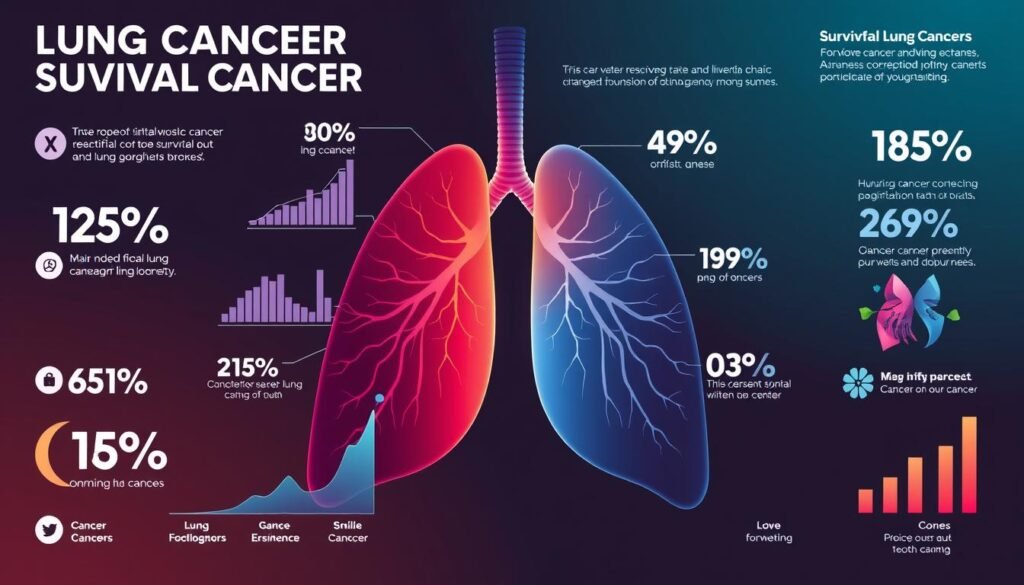In 2020, lung cancer led to around 1.80 million cancer deaths worldwide. This made it the top cause of cancer deaths that year. For those facing stage 4 lung cancer, knowing the life expectancy is essential. This thorough guide looks into lung cancer survival rates and what influences them.
The fact that less than 10% of patients live beyond five years is shocking. However, our guide aims to give clarity and important information. Knowing the prognosis and possible outcomes helps with decisions that can improve life quality and treatment options.
Key Takeaways
- Life expectancy for stage 4 lung cancer is often less than one year.
- The 5-year survival rate is below 10%, indicating critical challenges in treatment.
- Younger patients (under 50) have a higher probability of survival at 11% compared to older age groups.
- Palliative care is a primary focus, with treatments aimed at managing symptoms rather than curative outcomes.
- Understanding statistics can empower patients and families to make informed decisions.
Understanding Stage 4 Lung Cancer
Stage 4 lung cancer is the most severe form. It means the cancer has spread far from the lungs. The TNM system checks tumor size, lymph node involvement, and metastasis to classify it. At stage 4, spreading cancer makes treatment less effective.
This cancer level has two parts, 4a and 4b, based on how far it has spread. Stage 4a is when it’s spread nearby, and 4b is when it’s further away. These details help predict outcomes and shape advanced lung cancer prognosis.
People with this condition wonder about their life span and living quality. Age, health, and how well treatments work affect metastatic lung cancer life expectancy. Treatments aim to slow cancer, lessen symptoms, and improve life quality.
Research shows those with stage 4 lung cancer have different survival rates. This leads to various survival experiences. Knowing more helps in talking about choices and what to expect. For deep insights on stage 4 lung cancer, here’s a comprehensive guide.
What is Life Expectancy with Stage 4 Lung Cancer?
Understanding stage 4 lung cancer’s life expectancy is crucial for patients and their families. Upon diagnosis, there’s a flood of info about survival rates and treatments. It’s important to remember that these numbers are averages and experiences can differ greatly.
Five-Year Survival Rates for Stage 4 Lung Cancer
The five-year survival rates for stage 4 lung cancer are quite low. For metastatic NSCLC, which is most lung cancers, the rate is around 8%. SCLC has an even lower survival rate, about 3%. These numbers show the challenges faced after diagnosis.
Factors Impacting Life Expectancy
Life expectancy is affected by many factors. These include:
- Age: Most are diagnosed around the age of 70, mainly people 65 or older.
- Overall Health: Health status and existing conditions impact treatment and outcomes.
- Genetic Changes: Cancer cell genetics can affect how the disease progresses and reacts to therapy.
- NSCLC Subtype: Different NSCLC types respond uniquely to treatments.
- Treatment Effectiveness: Success of treatments like targeted therapy and immunotherapy can change survival rates.
About 25-30% of those with metastatic NSCLC live fewer than three months. Knowing these factors helps understand personal experiences with this tough diagnosis. While screenings and treatments are improving, survival rates remain low for all lung cancer types.

| Type of Lung Cancer | 5-Year Survival Rate |
|---|---|
| Non-Small Cell Lung Cancer (Metastatic) | 8% |
| Small Cell Lung Cancer (Metastatic) | 3% |
| Overall Lung Cancer | 18.6% |
Lung Cancer Survival Rates and Statistics
Lung cancer survival rates change a lot based on when it’s found. Looking closely, we see big differences, especially with stage 4 compared to earlier stages. Knowing these stats helps us understand how well treatments work.
Comparison of Different Lung Cancer Stages
When we compare lung cancer stages, we see survival rates drop as the disease gets worse. For example:
| Stage | Five-Year Survival Rate |
|---|---|
| Stage 1 | 65% |
| Stage 2 | 40% |
| Stage 3 | 15% |
| Stage 4 | 5% |
About 65% of stage 1 patients live five years after finding out they have cancer. But, only 5% of stage 4 patients reach this milestone. This shows why finding cancer early and effective treatments are important.
Gender Disparities in Survival Rates
Survival rates also differ between men and women. Men often have worse outcomes than women. Here are some specifics:
- Five-year survival rate for men with stage 4 lung cancer: 5.6%
- Five-year survival rate for women with stage 4 lung cancer: 8.6%
These differences highlight the need for treatments that consider gender. This could lead to better results for everyone. As we learn more, focusing on these differences will help improve lung cancer care.

The Role of Age in Lung Cancer Prognosis
Age plays a key role in the outlook for lung cancer patients. Older patients often face more hurdles. This is because health issues make their treatment and recovery harder. Younger and older people’s survival rates are quite different. This helps doctors decide on treatment and what to expect.
Age-Related Survival Rates
Survival rates change a lot with age. For example, those under 60 have a one-year survival rate of 67.3%. This is much higher than the 42.5% for older individuals. This shows we need different plans for people of different ages. Here’s a table that shows survival times for various age groups:
| Age Group | Median Survival (Years) |
|---|---|
| 2.0 | |
| 60–69 years | 1.5 |
| 70–79 years | 1.6 |
| ≥80 years | 1.0 |
People 80 and over have a much lower survival chance. Older patients with small cell lung cancer do especially poorly.
How Age Affects Treatment Options
Younger patients often have access to more aggressive treatments. These can lead to better outcomes. But older patients might not get these treatments. They have other health problems and are more likely to get complications like anemia.
Only 71.8% of those 80 or older get treated for cancer. This is much less than the 93.2% of younger patients. This shows the tough choices faced by older patients. It’s vital for doctors to consider age and health before choosing a treatment. The rate of older patients sent for care to make them comfortable is higher at 44% compared to 27.9% for the younger group.
It’s crucial to understand how age impacts lung cancer care. Age influences both the prognosis and treatment options. More information on chronic lung diseases and their link to previous infections can be found here.
Advanced Lung Cancer Prognosis and Statistics
Many patients with advanced lung cancer face a tough outlook, especially if it has spread. The median survival time after being diagnosed is about 4 months. Survival rates are very low, showing the difficulty of dealing with this disease.

Statistics for metastatic lung cancer are even more concerning. For those with small cell lung cancer, the 5-year survival rate drops to 3%. In the U.S., about 40% of lung cancers are found at stage IV. This makes finding the cancer early crucial for better outcomes.
But there is some hope thanks to progress in clinical trials and treatments. Research is aimed at improving the future for lung cancer patients. If lung cancer is found early, the chances of survival improve a lot. Despite daunting statistics, ongoing research and treatment advances offer hope for better results ahead.
Factors Influencing Survival Rates
It’s essential to know what affects survival rates in lung cancer patients. Several things matter a lot, like how well a person can do everyday tasks and other health problems they might have. These factors can change what treatments are possible and what to expect in the future.
Performance Status and Its Impact on Prognosis
How a patient can handle daily life is crucial for predicting their future. The Eastern Cooperative Oncology Group (ECOG) measures this. The scores go from 0 (doing everything) to 5 (dead). Patients with scores of 0 to 1 often have better outcomes.
On the other hand, those with lower scores face tougher challenges for treatment and survival.
Comorbid Conditions Affecting Life Expectancy
Other health issues, like heart disease or diabetes, can worsen lung cancer outcomes. These conditions make it harder to plan and carry out treatment. People who are healthier overall may be able to have more intense treatments, like surgery, which can help them live longer.
Knowing about these health issues can lead to treatments that are more tailored to the individual. You can find more info on treatment options here.
| Performance Status (ECOG Score) | Likelihood of Favorable Outcomes |
|---|---|
| 0 – Fully active | High |
| 1 – Restricted in physically strenuous activity | Moderate |
| 2 – Ambulatory but unable to perform work | Low |
| 3 – Capable of only limited self-care | Very Low |
| 4 – Completely disabled | Minimal |
When it comes to comorbid conditions lung cancer, it’s key to deal with these health issues. Talking with healthcare providers about all possible treatments helps in getting the best care. This plays a big part in survival rates and how good one’s life can be.
Explore more about the critical factors that impact survival rates
Treatment Options for Stage 4 Lung Cancer
Stage 4 lung cancer treatments focus on symptom management, extending life, and improving quality of life. Patients have various options that aim not for a cure but for the best outcomes. Treatments like chemotherapy, targeted therapies, radiation, and immunotherapy are commonly used.
Terminal Lung Cancer Treatment Options
Terminal lung cancer treatments aim at comfort and health. Options include:
- Chemotherapy: Often involves drug combinations such as cisplatin and gemcitabine.
- Targeted therapy: Uses drugs like erlotinib and osimertinib for those with certain mutations.
- Radiation therapy: Helps ease symptoms, especially pain from metastases in bones or the brain.
- Palliative procedures: Techniques like pleurodesis or stent placements reduce discomfort.
These treatments seek to ease symptoms and improve quality of life for patients.
Innovative Therapies and Clinical Trials
Lung cancer clinical trials play a crucial role in advanced cancer care. They offer access to new therapies. Innovations include:
- Immunotherapy: Drugs like pembrolizumab and nivolumab boost the immune fight against cancer.
- Targeted therapies: Genetic testing allows for drugs targeting specific mutations, e.g., sotorasib for KRAS G12C.
- Endobronchial therapies: Useful for clearing tumor-related blockages.
Clinical trials provide new treatment avenues, potentially improving symptoms and survival chances. They symbolize hope for many facing stage 4 lung cancer.
| Treatment Type | Description | Target Patients |
|---|---|---|
| Chemotherapy | Combination of drugs to kill cancer cells. | Advanced stage patients |
| Targeted Therapy | Drugs that target specific genetic mutations. | Patients with specific mutations (e.g., EGFR, ALK) |
| Radiation Therapy | High-energy rays to shrink tumors and relieve symptoms. | Patients with metastases causing pain |
| Immunotherapy | Boosts the body’s immune system to fight cancer. | Patients with specific biomarkers |
| Palliative Care | Focus on relieving symptoms and stress, improving quality of life. | All stages of lung cancer |
Palliative Care for End-Stage Lung Cancer
Palliative care for end-stage lung cancer is essential in managing symptoms. It improves life quality for patients during this tough phase. Rather than trying to cure the disease, palliative care eases discomfort. It tackles pain, breathlessness, and emotional stress. A team of doctors, nurses, social workers, and spiritual advisors work together. They offer support tailored to each person’s needs.
As the disease gets worse, patients face many challenges. They may feel very tired, lose weight, and have trouble breathing. This is often because of fluid around the lungs. Palliative care experts use medicine, oxygen, and procedures to remove fluid and make patients comfortable. Their approach is not just physical. It includes emotional and psychological support for patients and their families.
Understanding patients’ emotional and spiritual needs is key at this stage. Patients go through big changes as they accept their situation. Families need help coping with these changes too. Palliative care isn’t only about making the dying comfortable. It’s also about making life richer for those who remain. It ensures patients live as well as they can until the end. By focusing on all care aspects, palliative care improves life quality in the final days.